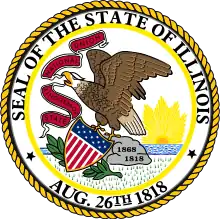Len Small | |
|---|---|
.jpg.webp) | |
| 26th Governor of Illinois | |
| In office January 10, 1921 – January 14, 1929 | |
| Lieutenant | Fred E. Sterling |
| Preceded by | Frank Orren Lowden |
| Succeeded by | Louis Lincoln Emmerson |
| 33rd and 39th Treasurer of Illinois | |
| In office 1917–1919 | |
| Governor | Frank Orren Lowden |
| Preceded by | Fred E. Sterling |
| Succeeded by | Andrew Russel |
| In office 1905–1907 | |
| Governor | Charles S. Deneen |
| Preceded by | Fred A. Busse |
| Succeeded by | John F. Smulski |
| Member of the Illinois Senate from the 20th district | |
| In office 1902–1904 | |
| Preceded by | re-districted |
| Succeeded by | Edward C. Curtis |
| Member of the Illinois Senate from the 16th district | |
| In office 1900–1902 | |
| Preceded by | Isaac Miller Hamilton |
| Succeeded by | re-districted |
| Personal details | |
| Born | June 16, 1862 Kankakee County, Illinois, U.S. |
| Died | May 17, 1936 (aged 73) Kankakee, Illinois, U.S. |
| Political party | Republican |
| Spouse | Ida Moore |
| Alma mater | Valparaiso University |
Lennington "Len" Small (June 16, 1862 – May 17, 1936) was an American politician who served as the 26th Governor of Illinois from 1921 to 1929. He previously was a member of the Illinois state senate from the 16th District from 1901 to 1903 and was Illinois state treasurer, from 1905 to 1907, and from 1917 to 1919. He is known for accusations of embezzlement brought against him.
Early life
Small was born in Kankakee County, Illinois, and attended public education at Northern Indiana Normal School, now Valparaiso University,[1] through his senior year. After schooling, became a teacher, and invested in real estate, eventually owning a farm, a bank, and Kankakee's daily newspaper. In 1883, Small married Ida Moore, and they had three children together. Six months after the Governor's inauguration, on June 26, 1922, Ida Moore Small died suddenly from apoplexy (the term at the time for a stroke) at the age of 60 while Small and his wife were being welcomed home following his acquittal on charges of embezzlement.[2]
Political career
Small's political career began in 1896 when he was elected Clerk of the Kankakee County Circuit Court. In 1900, Small was elected to the Illinois Senate from the 20th district.[3] He served in the Illinois Senate from 1901 to 1905.[4] The 20th district included Grundy, Iroquois, and Kankakee counties.[5] Small was the Illinois Treasurer from 1905 to 1907, and again from 1917 to 1919. He served as the assistant U.S. Treasurer in charge of the sub treasury at Chicago from 1908 to 1912, and was a delegate to Republican National Convention from Illinois in 1908, 1912, and 1932.
Small was elected governor of Illinois in 1920 and was reelected in 1924. He was indicted, six months after becoming governor, for embezzling over a million dollars in a money-laundering scheme in which he placed state funds into a fake bank while he was state treasurer.[6] He was acquitted, but eight jurors later got state jobs, raising suspicions of jury tampering.[7]
As governor, Small pardoned 20 members of the Communist Labor Party of America, convicted under the Illinois Sedition Act. He also pardoned or paroled over 1000 convicted felons, including Harry Guzik, brother of the Chicago Outfit's Jake Guzik, of Posen, Illinois, who was convicted of kidnapping young girls and forcing them into lives of prostitution (then commonly called white slavery).[8]
In 1923, bootlegger Edward "Spike" O'Donnell of Southside Chicago was released from prison by Small. O'Donnell returned to Chicago as the leader of one of the most powerful bootlegging gangs in the city.[9]
_at_Mound_Grove_Cemetery_1.jpg.webp)
Small's reputation for corruption finally caught up with him at the ballot box when he was defeated in the 1928 Republican "Pineapple Primary" by a margin of 63% to 37% against Louis Lincoln Emmerson, the incumbent Illinois Secretary of State. Small made a failed run for governor in 1932, and another in 1936.
Death
Small died on May 17, 1936. He is buried at Mound Grove Cemetery in Kankakee, Illinois.
References
- ↑ "Illinois Governor Lennington Small". National Governors Association. Retrieved October 30, 2012.
- ↑ "Gov. Small's Wife Dying from Apoplexy; Stricken on Return from Husband's Trial". The New York Times. June 26, 1922. p. 1. Retrieved May 8, 2022 – via Newspapers.com.
- ↑ Rose, James A., ed. (1903). "Legislative Department". Illinois Blue Book 1903-1904. Springfield, Illinois: Illinois Secretary of State. p. 364. Retrieved February 7, 2023.
- ↑ "Small, Lennington (1862-1936)". The Political Graveyard. Retrieved October 30, 2012.
- ↑ Illinois Blue Book 1903-1904, page 42
- ↑ Ridings, Jim (2010). Chicago to Springfield: Crime and Politics in the 1920s. Charleston, South Carolina: Arcadia Publishing. p. 31.
- ↑ Benzkofer, Stephan (June 19, 2011). "Len Small: Perhaps the Dirtiest Illinois Governor of Them All". Chicago Tribune. Chicago: Tribune Co. Retrieved June 19, 2017.
- ↑ Hoffman, Dennis E. (2010). Scarface Al and the Crime Crusaders: Chicago's Private War Against Capone. Carbondale, IL: SIU Press. p. 129. ISBN 978-0809330041.
- ↑ Keefe, Rose (2003). Guns and Roses: The Untold Story of Dean O'Banion, Chicago's Big Shot Before Al Capone. Nashville, TN: Cumberland House Publishing. p. 149. ISBN 1581823789.
Further reading
External links
This article incorporates facts obtained from: Lawrence Kestenbaum, The Political Graveyard
